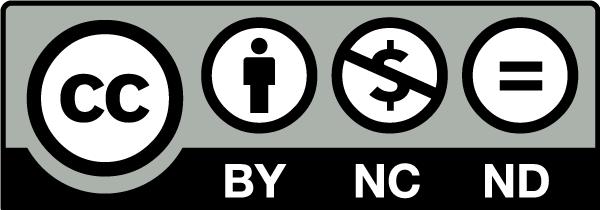World Englishes and English as a Lingua Franca: Implications for Teacher Education and ELT
DOI:
https://doi.org/10.13136/2281-4582/2015.i6.302Abstract
The spread of English, first as a consequence of colonization and then of globalization processes, has brought to a diversification of Englishes. Rather than a monolithic language, connected solely to native Anglophone speakers, English has taken nowadays a plurality of forms, from Inner and Outer circle varieties to its lingua franca function as a means of communication among speakers of different L1s across the world. Furthermore, English increasingly constitutes a consistent presence in the out-of-school environment: younger generations in particular come into contact with Englishes in a variety of contexts, from the media to the linguistic landscape; all over Europe encounters with (linguistic) otherness are experienced starting from increasingly multicultural and multilingual school environments.
This plurality has significant implications for ELT: first of all, awareness of the multifaceted realities of English ought to be promoted in teacher education to familiarize language educators with its implications in ELT, so that it can be acknowledged in classroom practices in order to prepare learners to be able to effectively communicate via English in its current plural dimension. This paper illustrates exemplifications of how WE- and ELF-informed activities can be incorporated into ELT classroom practices, drawing from two main datasets: lesson plans developed within university-run pre-service teacher education courses addressed at Italian secondary school English language trainee teachers (PAS/TFA), and from a project realized in three primary schools in Italy aimed at fostering awareness of English in the linguistic environment, of the plurality of English(es) and of its lingua franca role.
References
Barrats, Leslie. “Teaching the expanding universe of English.” Englishes in Multilingual Contexts: Language Variation and Education. Eds. Mahboob Ahmar and Barrat Leslie. London: Springer, 2014. 99-113.
Bayyurt, Yasemin, and Nicos C. Sifakis. “Developing an ELF-Aware Pedagogy: Insights from a SelfEducation Programme.” New Frontiers in Teaching and Learning English. Ed. Paola Vettorel. Newcastle-upon-Tyne: Cambridge Scholars, 2015. 55-76.
Berns, Margie, Kees De Bot, and Uwe Hasebrink, eds. In the Presence of English: Media and European Youth. New York: Springer, 2007.
Brown, James D. “EIL Curriculum Development.” Principles and Practices for Teaching English as an International Language. Eds. Lubna Alsagoff, Sandra Lee McKay, Guangwei Hu, and Willy A. Renadya. London: Routledge, 2012. 147-167.
Byram, Michael. Teaching and Assessing Intercultural Competence. Clevedon: Multilingual Matters, 1997.
Brown, James D. From Foreign Language Education to Education for Intercultural Citizenship. Clevedon: Multilingual Matters, 2008.
Cogo, Alessia. “ELF and Super-diversity: A Case Study of ELF Multilingual Practices from a Business Context.” Journal of English as a Lingua Franca 1.2 (2012): 287-313.
Cogo, Alessia and Martin Dewey. Analysing English as a Lingua Franca. London: Continuum, 2012.
Cook, Vivian. “Multi-competence.” 2010. http://homepage.ntlworld.com/vivian.c/Writings/Papers/MCentry.htm. Last visited 12/10/2015.
Coonan, Carmel Mary. La Lingua Straniera Veicolare. Torino: UTET, 2012.
Crystal, David. English as a Global Language. 1997. Cambridge: Cambridge University Press, 2003.
Danet, Brenda, and Susan C. Herring, eds. The Multilingual Internet: Language, Culture and Communication Online. Oxford: Oxford University Press, 2007.
D’Angelo, James. “WE-informed EIL Curriculum at Chuko: Towards a Functional, Educated, Multilingual Outcome.” Principles and Practices of Teaching English as an International Language. Ed. Aya Matsuda Bristol: Multilingual Matters, 2012. 121-136.
Dewey, Martin. “Time to Wake Up Some Dogs! Shifting the Culture of Language in ELT.” Current Perspectives on Pedagogy for English as a Lingua Franca. Eds. Yasemin Bayyurt and Sumru Akcan. Berlin: Mouton de Gruyter, 2015. 121-134
Dewey, Martin. “Towards a Post-normative Approach: Learning the Pedagogy of ELF.” Journal of English as a Lingua Franca 1.1 (2012): 141-170.
Floris, Flora D. “Exploring Teachers’ Beliefs on the Teaching of English in English Language Courses in Indonesia.” The Philippine ESL Journal 11 (2013): 4-24.
Friedrich, Patricia. “ELF, Intercultural Communication and the Strategic Aspect of Communicative Competence.” Principles and Practices of Teaching English as an International Language. Ed. Aya Matsuda. Bristol: Multilingual Matters, 2012. 44-54.
Galloway, Nicola. “Global Englishes and English Language Teaching (ELT) – Bridging the Gap between Theory and Practice in a Japanese context.” System 41 (2013): 786-803.
Giorgis, Paola. Diversi da sé, simili agli Altri. L2, immaginazione e letteratura come pratiche di pedagogia interculturale. Torino: CISU Centro d’Informazione e Stampa Universitaria, 2013.
Graddol, David. The Future of English. London: The British Council, 1997.
Graddol, David. English Next. London: The British Council, 2006.
Grau, Marie. “Worlds Apart? English in German Youth Cultures and in Educational Settings.” World Englishes 28.2 (2009): 160-174.
Hall, Christopher J., Rachel Wikaksono, Shu Liu, Yuan Qian, and Xu Xiaoqing. English Reconceived: Raising Teachers’ Awareness of English as a ‘Plurilithic’ Resource through an Online Course. London: The British Council, 2013.
Herring, Susan C. “Language and the Internet.” International Encyclopedia of Communication. Ed. Wolfgang Donsbach. Oxford: Blackwell Publishers, 2008. 2640-2645.
House, Juliane. “Teaching Oral Skills in English as a Lingua Franca.” Principles and Practices for Teaching English as an International Language. Eds. Lubna Alsagoff, Sandra L. McKay, Guangwei. Hu, and Willy A. Renandya. London: Routledge, 2012. 186-205.
Hülmbauer, Cornelia. “‘You Moved, Aren’t?’ – The Relationship between Lexicogrammatical Correctness and Communicative Effectiveness in English as a lingua Franca.” Vienna English Working PaperS 16.2 (2007): 3-35.
Hülmbauer, Cornelia. “’We Don’t Take the Right Way. We Just Take the Way We Think You Will Understand’ – The Shifting Relationship of Correctness and Effectiveness in ELF Communication.” English as a Lingua Franca: Studies and Findings. Eds. Anna Mauranen and Elina Ranta. Newcastle-upon-Tyne: Cambridge Scholars, 2009. 323-347.
Jenkins, Jennifer. Global Englishes. London: Routledge, 2015.
Jenkins, Jennifer. English as a Lingua Franca in the International University: The Politics of Academic English Language Policy. London: Routledge, 2014.
Jenkins, Jennifer. “Points of View and Blind Spots: ELF and SLA”. International Journal of Applied Linguistics 16.2 (2006): 138-162.
Jenkins, Jennifer. The Phonology of English as an International Language. Oxford: Oxford University Press, 2000.
Jenkins, Jennifer, Alessia Cogo, and Martin Dewey. “Review of Developments in Research into English as a Lingua Franca.” Language Teaching 44 (2011): 281-315.
Kopperoinen, Anne. “Accents of English as a Lingua Franca.” International Journal of Applied Linguistics 21.1 (2011): 71-93.
Kubota, Ryuko. “The Politics of EIL: Toward Border-crossing Communication in and Beyond English”. Principles and Practices of Teaching English as an International Language. Ed. Aya Matsuda Bristol: Multilingual Matters, 2012. 55-69.
Lee, Hyewon. “World Englishes in a High School English class: A Case from Japan.” Principles and Practices of Teaching English as an International Language. Ed. Aya Matsuda Bristol: Multilingual Matters, 2012. 154-168.
Lopriore, Lucilla, and Paola Vettorel. “Promoting Awareness of Englishes and ELF in the English Language Classroom.” International Perspectives on English as a Lingua Franca: Pedagogical Insights. Eds. Hugo Bowles and Alessia Cogo. Basingtoke: Palgrave Macmillan, 2015. 13-34.
Lopriore, Lucilla, and Paola Vettorel. “A Shift in ELT Perspective: World Englishes and ELF in the EFL Classroom.” 7th International Conference of English as a Lingua Franca (ELF7)/Conference Proceedings. forthcoming.
Llurda, Enric. “Attitudes towards English as an International Language. The Pervasiveness of Native Models among L2 Users and Teachers.” English as an International Language: Perspectives and Pedagogical Issues. Ed. Farzad Sharifian. Clevedon: Multilingual Matters, 2009. 119.134.
Mariani, Luciano. Communication Strategies. Learning Paths – Tante Vie Per Imparare, 2010.
Marlina, Roby. “The Pedagogy of English as an International Language (EIL): More Reflections and Dialogues.” The Pedagogy of English as an International Language: Perspectives from Scholars, Teachers and Students. Eds. Marlina Roby and R. Ashish Giri. London: Springer, 2014. 1-19.
Matsuda, Aya. “Teaching Materials in EIL.” Principles and Practices for Teaching English as an International Language. Eds. Lubna Alsagoff, Sandra L. McKay, Guangwei Hu, and Willy A. Renandya. London: Routledge, 2012a. 168-185.
Matsuda, Aya. “Introduction”. Principles and Practices of Teaching English as an International Language. Ed. Aya Matsuda. Bristol: Multilingual Matters, 2012b. 1-14.
Matsuda, Aya. (ed). Principles and Practices of Teaching English as an International Language. Bristol: Multilingual Matters, 2012c.
Matsuda, Aya. “Desirable but not Necessary? The Place of World Englishes and English as an International Language in English Teacher Preparation Programs in Japan.” English as an International language: Perspectives and Pedagogical Issues. Ed. Farzad Sharifian. Clevedon: Multilingual Matters, 2009. 169-189.
Matsuda, Aya. “The Ownership of English in Japanese Secondary Schools.” World Englises 22.4 (2003a): 483-496.
Matsuda, Aya. “Incorporating World Englishes in Teaching English as an International Language.” TESOL Quarterly 37.4 (2003b): 719-729.
Matsuda Aya, and Patricia Friedrich. “Selecting an Instructional Variety of English.” Principles and Practices of Teaching English as an International Language. Ed. Aya Matsuda. Bristol: Multilingual Matters, 2012. 17-27.
Matsuda, Aya, and Chatwara S. Duran. “EIL Activities and Tasks for Traditional English Classrooms.” Principles and Practices of Teaching English as an International Language. Ed. Aya Matsuda. Bristol: Multilingual Matters, 2012. 201-237.
Mauranen, Anna. “What Is Going on in Academic ELF? Findings and Implications.” New Frontiers in Teaching and Learning English. Ed. Paola Vettorel. Newcastle-upon-Tyne: Cambridge Scholars, 2015. 31-52.
Mauranen, Anna. Exploring ELF: Academic English Shaped by Non-native Speakers. Cambridge: Cambridge University Press, 2012.
McKay, Sandra L. Teaching English as an International Language. Oxford: Oxford University Press, 2002.
McKay, Sandra L. “Teaching Materials for English as an International Language.” Principles and Practices of Teaching English as an International Language. Ed. Aya Matsuda Bristol: Multilingual Matters, 2012a. 70-83.
McKay, Sandra L. “Principles of Teaching English as an International Language.” Principles and Practices for Teaching English as an International Language. Eds. Lubna Alsagoff, Sandra L. McKay, Guangwei Hu, and Willy A. Renandya London: Routledge, 2012b. 28-46.
McKay, Sandra L. “Toward an Appropriate EIL Pedagogy: Re-examining Common ELT Assumptions.” International Journal of Applied Linguistics 13 (2003): 1–22.
MIUR. Indicazioni Nazionali per il Curricolo della Scuola dell’Infanzia e del Primo Ciclo di Istruzione. Roma, 2012.
Naji Meidani, Elham and Reza Pishghadam. “Analysis of English Language Textbooks in the Light of English as an International Language (EIL): A Comparative Study.” International Journal of Research Studies in Language Learning 2.2 (2013): 83-96. http://profdoc.um.ac.ir/articles/a/1029016.pdf. Last visited 10/12/2015.
Pedrazzini, Luciana. “Raising Trainee Teachers’ Awareness of Language Variation through Data-based Tasks.” New Frontiers in Teaching and Learning English. Ed. Paola Vettorel. Newcastle-upon-Tyne: Cambridge Scholars, 2015. 77-102.
Preisler, Bent. “Functions and Forms of English in a European EFL Country.” Standard English: the Widening Debate. Eds. Tony Bex and Richard J. Watts. London: Routledge, 1999. 239–267.
Saraceni, Mario. World Englishes: A Critical Analysis. London: Bloomsbury Academics, 2015.
Schneider, Edgar W. English around the World: An Introduction. Cambridge: Cambridge University Press, 2011.
Seargeant, Philip and Caroline Tagg. “English on the Internet and a ‘Post-varieties’ Approach to Language.” World Englishes 30.4 (2011): 496-514.
Seidlhofer, Barbara. Understanding English as a Lingua Franca. Oxford: Oxford University Press, 2011.
Seidlhofer, Barbara. 2009. “Common Grounds and Different Realities: World Englishes and English as a Lingua Franca.” World Englishes 28.2 (2009): 236-245.
Seidlhofer, Barbara. “Common Property: English as a Lingua Franca in Europe.” International Handbook of English Language Teaching. Eds. Jim Cummins, Chris Davidson. New York: Springer, 2007. 137-153.
Seidlhofer, Barbara, Angelika Breiteneder, and Marie_Luise Pitzl. “English as a Lingua Franca in Europe: Challenges for Applied Linguistics.” Annual Review of Applied Linguistics 26 (2006): 3-34.
Sifakis, Nicos C. “ELF Awareness as an Opportunity for Change: A Transformative Perspective for ESOL Teacher Education.” Journal of English as a Lingua Franca 3.2 (2014): 317-335.
Sifakis, Nicos C. and Richard J. Fay. “Integrating an ELF Pedagogy in a Changing World: The Case of Greek State Schooling.” Latest Trends in ELF Research. Eds. Alasdair Archibald, Alessia Cogo, and Jennifer Jenkins. Newcastle upon Tyne: Cambridge Scholars, 2011. 285-298.
Sifakis, Nicos C. and Areti-Maria Sougari. “Pronunciation Issues and EIL Pedagogy in the Periphery: A Survey of Greek State School Teachers’ Beliefs.” TESOL Quarterly 39 (2005): 467-488.
Tomkinson, Angela and Elizabeth Lee. Think Global: A Cultural Journey through the English-Speaking World. Recanati: ELI, 2013.
Vettorel, Paola. “Primary School Teachers’ Perceptions: Englishes, ELF and Classroom Practices – between ‘Correctness’ and ‘Communicative Effectiveness.’” New Frontiers in Teaching and Learning English. Ed. Paola Vettorel. Newcastle-upon-Tyne: Cambridge Scholars, 2015a.129-155.
Vettorel, Paola. (ed.). New Frontiers in Teaching and Learning English. Newcastle-upon-Tyne: Cambridge Scholars, 2015b.
Vettorel, Paola. English as a Lingua Franca in Wider Networking: Blogging Practices. Berlin: Mouton De Gruyter, 2014a.
Vettorel, Paola. “Connecting English Wor(l)ds and Classroom Practices.” TEXTUS XXVII/1 (January-April), Perspectives on English as a Lingua Franca, eds. Maria G. Guido and Barbara Seidlhofer. (2014b): 137-154.
Vettorel, Paola. “ELF in International School Exchanges: Stepping into the Role of ELF Users.” Journal of English as a Lingua Franca 2.1 (2013): 147-173.
Vettorel, Paola. “English(es), ELF, Xmas and Trees: Intercultural Communicative Competence and English as a Lingua Franca in the Primary Classroom.” Perspectives - A Journal of TESOL Italy XXXVII/1 (2010): 25-52.
Vettorel, Paola and Lucilla Lopriore. “Is There ELF in ELT Coursebooks?” Studies in Second Language Learning and Teaching 3.4 (2013): 483-504.
Xu, Zhichang. “Globalization, Culture and ELT Materials: A Focus on China.” Multilingual Education 3/6 (2013): n.p.
Widdowson, Henry G. “Afterword. Frontiers of English and the Challenge of Change.” New Frontiers in Teaching and Learning English. Ed. Paola Vettorel. Newcastle-upon-Tyne: Cambridge Scholars, 2015. 227-232.
Widdowson, Henry G. “ELF and the Inconvenience of Established Concepts.” Journal of English as a Lingua Franca 1.1 (2012): 5-26.
Widdowson, Henry G. Defining Issues in English Language Teaching. Oxford: Oxford University Press, 2003.
Downloads
Published
Issue
Section
License
Copyright (c) 2015 Paola Vettorel

This work is licensed under a Creative Commons Attribution-NonCommercial 4.0 International License.
Iperstoria is an Open Access journal.- Authors retain copyright and grant the journal right of first publication with the work simultaneously licensed under a Creative Commons Attribution 4.0 BY-NC License that allows others to share the work with an acknowledgement of the work's authorship and initial publication in this journal.
- Authors are able to enter into separate, additional contractual arrangements for the non-exclusive distribution of the journal's published version of their work (e.g., post it to an institutional repository or publish it in a book), with an acknowledgement of its initial publication in this journal. We require authors to inform us of any instances of re-publication.







